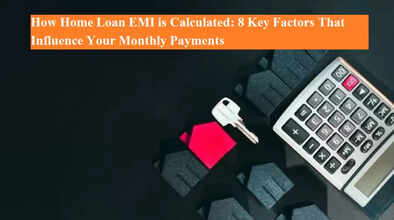How Home Loan EMI is Calculated: 8 Key Factors That Influence Your Monthly Payments

Buying a home is a dream for most people, and a home loan plays a crucial role in turning that dream into reality. While applying for a loan, the interest rate and EMI (Equated Monthly Installment) become the biggest deciding factors, directly impacting your monthly budget.
But what exactly determines your EMI? Let’s explore the 8 most important factors that influence home loan interest rates and EMI calculations.
1. Impact of Credit Score
Your credit score reflects your repayment history and overall financial credibility.
-
A high credit score means banks trust you more and offer lower interest rates.
-
A poor credit score makes it harder to secure a loan or may result in higher rates.
👉 Timely EMI and credit card payments help maintain a healthy score.
2. Loan-to-Value (LTV) Ratio
The LTV ratio indicates how much loan a bank will provide compared to the property’s value.
-
Higher down payment = lower risk for the bank → reduced interest rate.
-
Higher LTV = increased risk for the lender → higher interest rates.
Maintaining the right balance is beneficial for borrowers.
3. Market Conditions
The state of the economy directly impacts lending rates.
-
During high inflation, banks usually increase interest rates to manage risks.
-
In a stable economy, interest rates are often more affordable.
👉 Timing your loan application can make a difference.
4. Income Stability and Employment Type
Lenders carefully evaluate your income source and employment type.
-
Stable income & permanent job = better loan terms and lower interest rates.
-
Unstable job or low income = higher interest rates due to increased risk.
5. Fixed-Rate Loans
In a fixed-rate home loan, the interest rate remains constant throughout the tenure or for a set period.
-
EMI stays stable, ensuring predictable monthly expenses.
-
Generally slightly higher than floating rates, but ideal for those who prefer stability.
6. Floating-Rate Loans
With a floating interest rate, your EMI changes with market fluctuations.
-
If rates drop → EMI becomes lighter.
-
If rates rise → EMI increases.
👉 Floating rates carry both risk and reward.
7. Size of the Down Payment
The larger your down payment, the less risk the bank faces.
-
Higher down payment = reduced interest rate.
-
Lower down payment = higher cost of borrowing.
👉 Aim for at least 20–25% down payment to reduce overall loan burden.
8. Loan Tenure (Duration)
Your loan tenure has a direct impact on EMI and total interest payout.
-
Longer tenure = smaller EMIs but higher total interest paid.
-
Shorter tenure = larger EMIs but significant interest savings.
👉 Choosing a balanced tenure according to your repayment capacity is the smartest move.
✅ Conclusion
Your home loan EMI is not determined by just the loan amount—it is shaped by multiple factors such as your credit score, down payment, loan tenure, and market conditions. By maintaining good financial discipline, making higher down payments, and choosing the right loan structure, you can reduce your overall interest burden and make your dream home more affordable.

